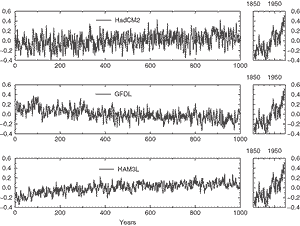E. The Identification of a Human Influence on Climate Change
Sections B and C characterised
the observed past changes in climate and in forcing agents, respectively. Section
D examined the capabilities of climate models to predict the response of the
climate system to such changes in forcing. This Section uses that information
to examine the question of whether a human influence on climate change to date
can be identified.
This is an important point to address. The SAR concluded that “the balance
of evidence suggests that there is a discernible human influence on global climate”.
It noted that the detection and attribution of anthropogenic climate change
signals will be accomplished through a gradual accumulation of evidence. The
SAR also noted uncertainties in a number of factors, including internal variability
and the magnitude and patterns of forcing and response, which prevented them
from drawing a stronger conclusion.
E.1 The Meaning of Detection and Attribution
Detection is the process of demonstrating that an observed change is
significantly different (in a statistical sense) than can be explained by natural
variability. Attribution is the process of establishing cause and effect
with some defined level of confidence, including the assessment of competing hypotheses.
The response to anthropogenic changes in climate forcing occurs against a backdrop
of natural internal and externally forced climate variability. Internal climate
variability, i.e., climate variability not forced by external agents, occurs on
all time-scales from weeks to centuries and even millennia. Slow climate components,
such as the ocean, have particularly important roles on decadal and century time-scales
because they integrate weather variability. Thus, the climate is capable of producing
long time-scale variations of considerable magnitude without external influences.
Externally forced climate variations (signals) may be due to changes in natural
forcing factors, such as solar radiation or volcanic aerosols, or to changes in
anthropogenic forcing factors, such as increasing concentrations of greenhouse
gases or aerosols. The presence of this natural climate variability means that
the detection and attribution of anthropogenic climate change is a statistical
“signal to noise” problem. Detection studies demonstrate whether
or not an observed change is highly unusual in a statistical sense, but this does
not necessarily imply that we understand its causes. The attribution of
climate change to anthropogenic causes involves statistical analysis and the careful
assessment of multiple lines of evidence to demonstrate, within a pre-specified
margin of error, that the observed changes are:
- unlikely to be due entirely to internal variability;
- consistent with the estimated responses to the given combination of anthropogenic
and natural forcing; and
- not consistent with alternative, physically plausible explanations of recent
climate change that exclude important elements of the given combination of
forcings.
E.2 A Longer and More Closely Scrutinised Observational Record

Figure 14: Global mean surface air temperature anomalies from 1,000
year control simulations with three different climate models, – Hadley,
Geophysical Fluid Dynamics Laboratory and Hamburg, compared to the recent
instrumental record. No model control simulation shows a trend in surface
air temperature as large as the observed trend. If internal variability
is correct in these models, the recent warming is likely not due to variability
produced within the climate system alone. [Based on Figure
12.1] |
Three of the last five years (1995, 1997 and 1998) were the warmest globally
in the instrumental record. The impact of observational sampling errors
has been estimated for the global and hemispheric mean temperature record. There
is also a better understanding of the errors and uncertainties in the satellite-based
(Microwave Sounding Unit, MSU) temperature record. Discrepancies between MSU
and radiosonde data have largely been resolved, although the observed trend
in the difference between the surface and lower tropospheric temperatures cannot
fully be accounted for (see Section B). New reconstructions
of temperature over the last 1,000 years indicate that the temperature changes
over the last hundred years are unlikely to be entirely natural in origin, even
taking into account the large uncertainties in palaeo-reconstructions (see Section
B).
E.3 New Model Estimates of Internal Variability
The warming over the past 100 years is very unlikely to be due to internal
variability alone, as estimated by current models. The instrumental record
is short and covers the period of human influence and palaeo-records include natural
forced variations, such as those due to variations in solar irradiance and in
the frequency of major volcanic eruptions. These limitations leave few alternatives
to using long “control” simulations with coupled models for the estimation
of internal climate variability. Since the SAR, more models have been used to
estimate the magnitude of internal climate variability, a representative sample
of which is given in Figure 14. As can be seen, there
is a wide range of global scale internal variability in these models. Estimates
of the longer time-scale variability relevant to detection and attribution studies
is uncertain, but, on interannual and decadal time-scales, some models show similar
or larger variability than observed, even though models do not include variance
from external sources. Conclusions on detection of an anthropogenic signal are
insensitive to the model used to estimate internal variability, and recent changes
cannot be accounted for as pure internal variability, even if the amplitude of
simulated internal variations is increased by a factor of two or perhaps more.
Most recent detection and attribution studies find no evidence that model-estimated
internal variability at the surface is inconsistent with the residual variability
that remains in the observations after removal of the estimated anthropogenic
signals on the large spatial and long time-scales used in detection and attribution
studies. Note, however, the ability to detect inconsistencies is limited. As Figure
14 indicates, no model control simulation shows a trend in surface air temperature
as large as the observed trend over the last 1,000 years.
|